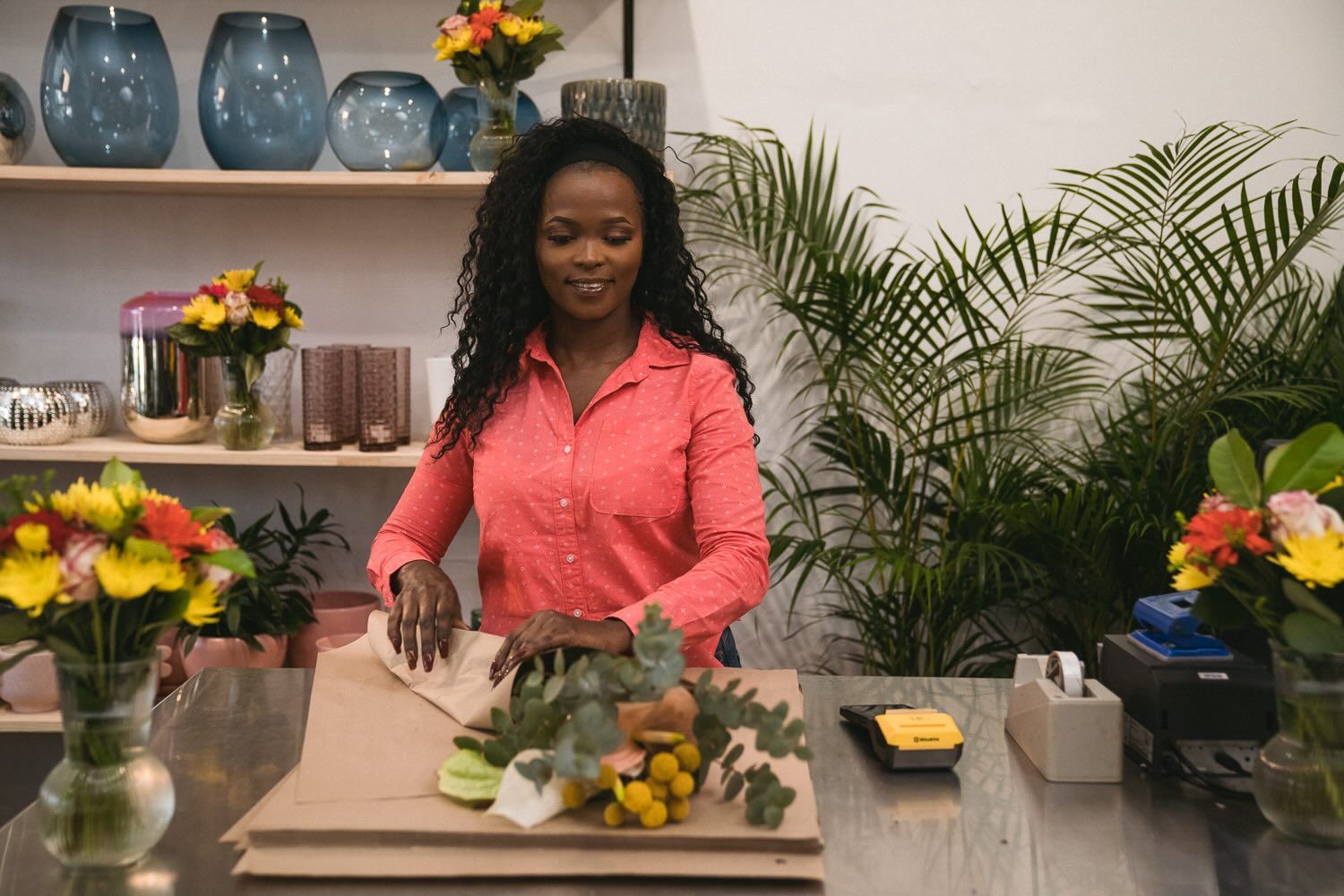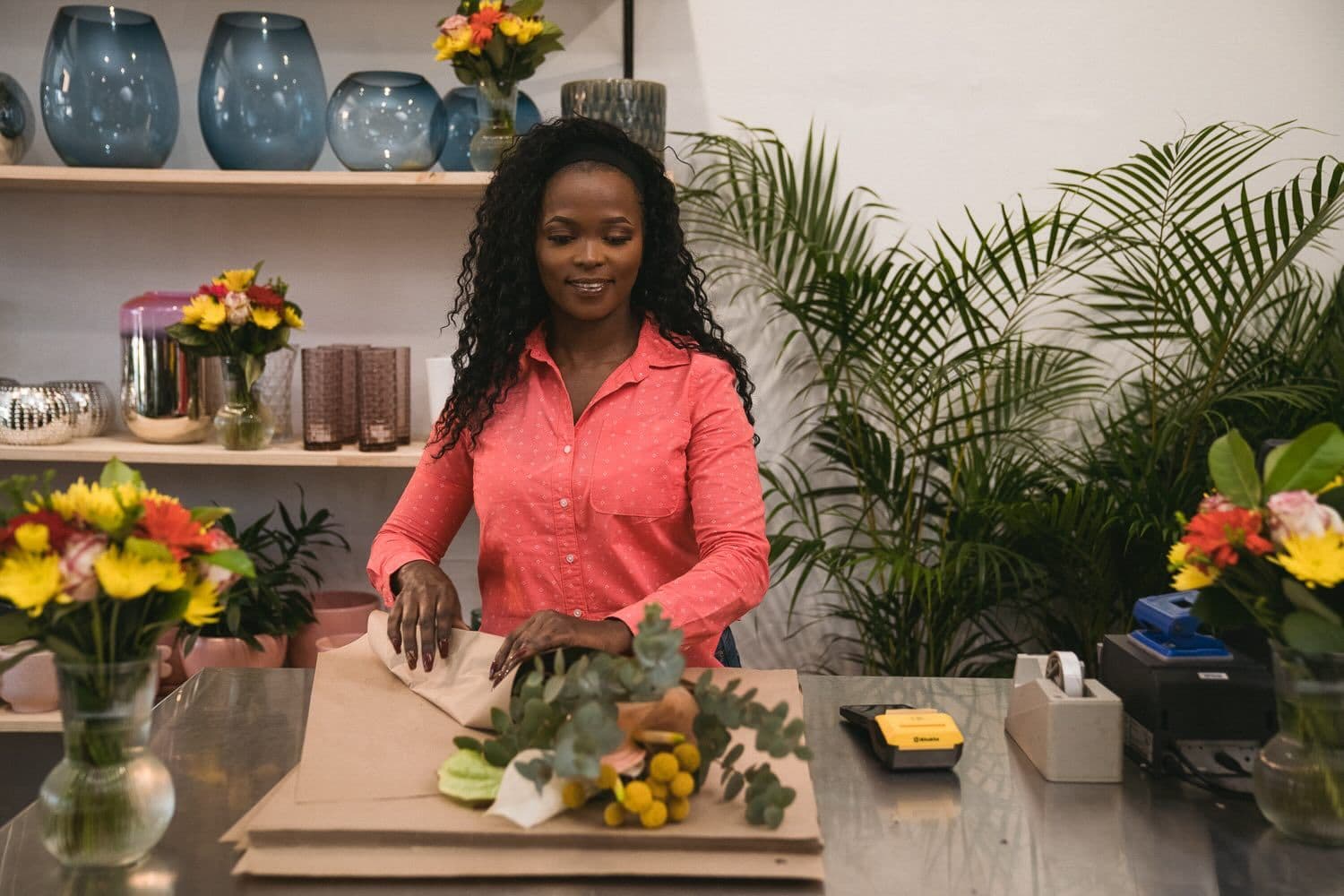
Bloom & Bank: How to Start a Floral Business in South Africa
Turn your passion for flowers into profit. Start a floral business in South Africa and get paid fast with iKhokha.
Table of Contents
- Introduction
- What is a floral business?
- Why start a floral business in South Africa?
- How to start a floral business
- Step 1: Find your floral niche
- Step 2: Build your business plan
- Step 3: Get registered and compliant
- Step 4: Find trusted suppliers
- Step 5: Set up shop (online or in-person)
- Step 6: Build your portfolio
- Step 7: Price right and promote smart
- Can a floral business be profitable?
- Tips for managing your flower business
- Tips for promoting your flower business
- Pros and Challenges of Floristry
- Why floristry works:
- What to prepare for:
- Starting from Home
- It’s your time to bloom
There’s something magical about flowers. If it’s a wedding bouquet, a birthday arrangement or a “just because” bunch, flowers have a way of brightening up any moment. If you’ve got a green thumb and an eye for design, turning your love for blooms into a business might just be your next big move.
If you’re wondering how to start a floral business in South Africa, you already have the passion. Now, let’s pair that passion with a practical plan tailored to local seasons, celebrations, and shopping habits. Add iKhokha from day one, and you’ll be ready to accept instant payments, keeping your cash flow fresh while you focus on creating bouquets that brighten lives.
What is a floral business?
A floral business is your creative outlet, a chance to work with colour, design, and nature every day. You might design centrepieces for weddings, sell bouquets at weekend markets, or offer subscription boxes that surprise regulars with fresh flowers each week.
The key to standing out is to choose a focus: weddings, events, retail, gifting or corporate. Specialising builds trust and makes your business memorable. You don’t have to do it all. Do what excites you, then do it well.
Why start a floral business in South Africa?
South Africans love to celebrate. From Valentine’s Day and Women’s Day to birthdays, graduations and all the spontaneous braais in between, flowers are always welcome. Our rich biodiversity and climate mean that locally sourced blooms are available in almost every season.
Add to that a growing shift towards card and online payments, and your flower business can thrive with the right tools. With iKhokha’s fast payment options, you avoid delays and make the sale, right when the emotion is high and the flowers are fresh.
How to start a floral business
Step 1: Find your floral niche
The first step in learning how to start a floral business is deciding what kind of florist you want to be. Do you dream of crafting wedding centrepieces, selling stems at weekend markets, or building a loyal customer base through subscription deliveries? Start with one clear focus, this will help you stand out and build a recognisable brand.
You can always expand your services later. But in the beginning, it’s easier (and more profitable) to master one thing at a time. Choose something that excites you and that your local market needs.
Step 2: Build your business plan
Before you start ordering roses and ribbon, you’ll need a plan. Do some local research:
- What flowers are popular in your area?
- Who are your competitors and what are they charging?
- What are your peak seasons (Valentine’s, Mother’s Day, etc.)?
- What are your startup costs (typically R8,000–R12,000)?
- How will you track your income and expenses?
Use tools like iK Accounting to manage finances from day one. A simple, localised business plan gives you clarity, and it’s much easier to stay on course when orders start rolling in.
Step 3: Get registered and compliant
To run legally and professionally, you’ll need to:
- Register your business with the CIPC
- Open a business bank account
- Check for municipal permits (especially if working from home or trading publicly)
Getting these basics sorted early protects you down the line and makes your business look more legit especially if you want to partner with corporates or wedding planners.
Step 4: Find trusted suppliers
Reliable suppliers are the backbone of any floral business. Start by connecting with local growers or wholesalers who can provide fresh, seasonal blooms at competitive prices. Look for:
- Consistent delivery schedules
- Quality assurance
- Transparent minimum order policies
Build relationships with people who understand your business goals. When your suppliers come through, your business thrives, especially during high-demand seasons like Valentine’s Day.
Step 5: Set up shop (online or in-person)
Not every florist needs a storefront. You can set up shop at:
- A weekend market
- A small studio
- Your home
Wherever you work from, your setup should feel welcoming, organised, and efficient.
If you’re trading in-person, use the iK Flyer or iK Flyer Lite to accept card payments easily on-site. For digital-first florists, the iK Webstore helps you sell online in minutes. It’s mobile-friendly and perfect for local customers looking for delivery or click-and-collect options.
Step 6: Build your portfolio
A great portfolio helps potential clients trust your work. Start by snapping high-quality photos of your best arrangements. Use natural light, neutral backgrounds, and clear descriptions (e.g. “Rustic wedding bouquet with proteas”).
Post your work on:
- Instagram and Facebook
- Your iK Webstore
- WhatsApp Business
The more consistent you are with your visual brand, the faster people will recognise and remember your name.
Step 7: Price right and promote smart
Your prices need to reflect more than just the cost of flowers. Factor in:
- Your time and skill
- Packaging
- Delivery costs
- Seasonal demand
Aim for a 25–35% profit margin once costs are covered.
Marketing doesn’t have to be expensive. Share behind-the-scenes videos, run seasonal specials, collaborate with photographers or venues, and ask clients to leave reviews. The best marketing is often word-of-mouth, so give clients something to rave about.
Can a floral business be profitable?
Definitely. Once you’ve found your rhythm with pricing and sourcing, floristry can offer healthy margins, especially when you add value through upsells like event styling or delivery packages. Cash flow is key, and that’s where tools like iKhokha shine.
Get paid fast. Reinvest quickly. Avoid lag time between sales and payouts. That kind of control is crucial for small businesses working with fresh stock and tight timelines.
Tips for managing your flower business
Keeping things organised is half the battle. Here’s how to run smoothly:
- Track all your expenses and invoices using iK Accounting
- Use a fridge or cooler box to extend the life of your blooms
- Prep early for big holidays like Valentine’s, Women’s Day, and Mother’s Day
- Stick to payment deadlines with suppliers to maintain trust
- Train seasonal helpers ahead of peak times to match your style
Tips for promoting your flower business
Your flowers do half the marketing, but here’s how to amplify their impact:
- Keep your branding consistent across platforms
- Share real photos from local events, markets or famous landmarks
- Host interactive Instagram content like “Bouquet of the Week” or flower crown tutorials
- Partner with nearby businesses for cross-promos
- Showcase 5-star reviews to build credibility with new clients
Pros and Challenges of Floristry
Why floristry works:
- Flexible working: home-based, mobile, or studio-based
- High demand around key events
- Low barrier to entry
What to prepare for:
- Flowers perish fast - order carefully and use stock strategically
- Competition is real - your unique flair is your superpower
- Delivery needs planning - make sure your stems arrive fresh and intact
Starting from Home
No shop? No stress. Many successful florists begin from home. Choose a well-lit room with water access, organise tools and supplies in labelled bins, and use buckets with clean water for storing stems.
You can run ads in your area, promote on Facebook Marketplace or WhatsApp, and offer click-and-collect or delivery.
It’s your time to bloom
Every bouquet you put together is shaping your brand and pulling in the customers who’ll keep coming back. That’s why having tools that grow alongside your business makes all the difference. iKhokha helps you take payments easily, manage online orders and access funding when you’re ready for the next step.
Once you know what to do, moving forward is easy. iKhokha makes it possible to get paid on the move, manage your money from your phone and grow your business at a pace that works for you.
The iK Flyer Lite is great on the move, while the iK Flyer handles busy trading days with ease.
Choose what suits your business and keep every sale quick and simple.




















